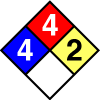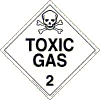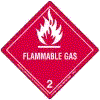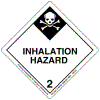Arsine (SA): Systemic Agent
CAS #:
7784-42-1
RTECS #: CG6475000
UN #: 2188 (Guide 119)
Common Names:
- Arsenic hydride
- Arsenic trihydride
- Hydrogen arsenide
- SA
Agent Characteristics
Colorless gas.
Arsine (SA) is a highly toxic gas, formed by the reaction of arsenic-containing substances with hydrogen in water or acids. It is used in the semiconductor and computer chip crystal manufacturing industry. Exposure to arsine (SA) in sufficient quantities can be fatal. Arsine (SA) is nonirritating, produces no immediate symptoms, and odor is not an adequate indicator of arsine’s (SA) presence, so persons exposed to hazardous levels may be unaware of its presence. The established PEL is 10 times lower than the concentration at which people begin to smell arsine (SA) (odor threshold of 0.5 ppm and above).
- Indoor Air: Arsine (SA) can be released into indoor air as a gas.
- Water: Not established/determined
- Food: Not established/determined
- Outdoor Air: Arsine (SA) can be released into outdoor air as a gas.
- Agricultural: Because arsine (SA) is not released into the air as fine particles (aerosol), it is highly unlikely to contaminate agricultural products.
Arsine (SA) can be absorbed into the body by inhalation. Ingestion is unlikely because arsine (SA) is a gas at room temperature. Metal arsenides are solids that can be ingested; they can react with stomach acids to release arsine (SA) gas. Information is limited about absorption of arsine (SA) through, or arsine’s (SA) toxic effects on, the skin or eyes.
Personal Protective Equipment
First Responders should use a NIOSH-certified Chemical, Biological, Radiological, Nuclear (CBRN) Self Contained Breathing Apparatus (SCBA) with a Level A protective suit when entering an area with an unknown contaminant or when entering an area where the concentration of the contaminant is unknown. Level A protection should be used until monitoring results confirm the contaminant and the concentration of the contaminant.
NOTE: Safe use of protective clothing and equipment requires specific skills developed through training and experience.
Select when the greatest level of skin, respiratory, and eye protection is required. This is the maximum protection for workers in danger of exposure to unknown chemical hazards or levels above the IDLH or greater than the AEGL-2.
- A NIOSH-certified CBRN full-face-piece SCBA operated in a pressure-demand mode or a pressure-demand supplied air hose respirator with an auxiliary escape bottle.
- A Totally-Encapsulating Chemical Protective (TECP) suit that provides protection against CBRN agents.
- Chemical-resistant gloves (outer).
- Chemical-resistant gloves (inner).
- Chemical-resistant boots with a steel toe and shank.
- Coveralls, long underwear, and a hard hat worn under the TECP suit are optional items.
Select when the highest level of respiratory protection is necessary but a lesser level of skin protection is required. This is the minimum protection for workers in danger of exposure to unknown chemical hazards or levels above the IDLH or greater than AEGL-2. It differs from Level A in that it incorporates a non-encapsulating, splash-protective, chemical-resistant splash suit that provides Level A protection against liquids but is not airtight.
- A NIOSH-certified CBRN full-face-piece SCBA operated in a pressure-demand mode or a pressure-demand supplied air hose respirator with an auxiliary escape bottle.
- A hooded chemical-resistant suit that provides protection against CBRN agents.
- Chemical-resistant gloves (outer).
- Chemical-resistant gloves (inner).
- Chemical-resistant boots with a steel toe and shank.
- Coveralls, long underwear, a hard hat worn under the chemical-resistant suit, and chemical-resistant disposable boot-covers worn over the chemical-resistant suit are optional items.
Select when the contaminant and concentration of the contaminant are known and the respiratory protection criteria factors for using Air Purifying Respirators (APR) or Powered Air Purifying Respirators (PAPR) are met. This level is appropriate when decontaminating patient/victims.
- A NIOSH-certified CBRN tight-fitting APR with a canister-type gas mask or CBRN PAPR for air levels greater than AEGL-2.
- A NIOSH-certified CBRN PAPR with a loose-fitting face-piece, hood, or helmet and a filter or a combination organic vapor, acid gas, and particulate cartridge/filter combination or a continuous flow respirator for air levels greater than AEGL-1.
- A hooded chemical-resistant suit that provides protection against CBRN agents.
- Chemical-resistant gloves (outer).
- Chemical-resistant gloves (inner).
- Chemical-resistant boots with a steel toe and shank.
- Escape mask, face shield, coveralls, long underwear, a hard hat worn under the chemical-resistant suit, and chemical-resistant disposable boot-covers worn over the chemical-resistant suit are optional items.
Select when the contaminant and concentration of the contaminant are known and the concentration is below the appropriate occupational exposure limit or less than AEGL-1 for the stated duration times.
- Limited to coveralls or other work clothes, boots, and gloves.
Emergency Response
- Arsine (SA) reacts with strong oxidants, causing an explosion hazard.
- Arsine (SA) decomposes on heating and under the influence of light and moisture, producing toxic arsenic fumes.
- Arsine (SA) is explosive.
- Lower explosive (flammable) limit in air (LEL), 5.1%; upper explosive (flammable) limit in air (UEL), 78%.
- Can explosively decompose on shock, friction, or concussion.
- Can explode on contact with warm, dry air.
- Containers may explode when heated.
- Ruptured cylinders may rocket.
- Arsine is flammable.
- The agent may be ignited by heat, sparks, or flames.
- Fire will produce irritating, corrosive, and/or toxic gases.
- Vapors may travel to the source of ignition and flash back.
- Do not extinguish a leaking gas fire unless the leak can be stopped.
- For small fires, use dry chemical, carbon dioxide, water spray, or alcohol-resistant foam.
- For large fires, use water spray, fog, or alcohol-resistant foam. Move containers from the fire area if it is possible to do so without risk to personnel. Damaged cylinders should be handled only by specialists.
- For fire involving tanks, fight the fire from maximum distance or use unmanned hose holders or monitor nozzles. Cool containers with flooding quantities of water until well after the fire is out. Do not direct water at the source of the leak or at safety devices; icing may occur. Withdraw immediately in case of rising sound from venting safety devices or discoloration of tanks. Always stay away from tanks engulfed in fire.
- Run-off from fire control may cause pollution.
- If the situation allows, control and properly dispose of run-off (effluent).
- If a tank, rail car, or tank truck is involved in a fire, isolate it for 1 mi (1600 m) in all directions; also consider initial evacuation for 1 mi (1600 m) in all directions.
- Small spills (involving the release of approximately 52.83 gallons (200 liters) or less), when arsine (SA) is used as a weapon
- First isolate in all directions: 200 ft (60 m).
- Then protect persons downwind during the day: 0.5 mi (0.9 km).
- Then protect persons downwind during the night: 1.5 (2.5 km).
- Large spills (involving quantities greater than 52.83 gallons (200 liters)), when arsine (SA) is used as a weapon
- First isolate in all directions: 1300 ft (420 m).
- Then protect persons downwind during the day: 2.5 mi (4.1 km).
- Then protect persons downwind during the night: 5.0 mi (8.1 km).
- Small spills (involving the release of approximately 52.83 gallons (200 liters) or less), when arsine (SA) is used
- First isolate in all directions: 200 ft (60 m).
- Then protect persons downwind during the day: 0.4 mi (0.6 km).
- Then protect persons downwind during the night: 1.9 mi (3.0 km).
- Large spills (involving quantities greater than 52.83 gallons (200 liters)), when arsine (SA) is used
- First isolate in all directions: 1400 ft (420 m).
- Then protect persons downwind during the day: 2.6 mi (4.1 km).
- Then protect persons downwind during the night: 5.9 mi (9.5 km).
- Vapors are heavier than air. They will spread along the ground and collect and stay in poorly-ventilated, low-lying, or confined areas (e.g., sewers, basements, and tanks).
- Hazardous concentrations may develop quickly in enclosed, poorly-ventilated, or low-lying areas. Keep out of these areas. Stay upwind.
- Health: 4
- Flammability: 4
- Reactivity: 2
- Special:

- OSHA: ID105
- NIOSH: 6001
- AIR MATRIX
Pantsar-Kallio M, Korpela A [2000]. Analysis of gaseous arsenic species and stability studies of arsine and trimethylarsine by gas chromatography-mass spectrometry. Anal Chim Acta 410(1-2):65-70. - OTHER
No references were identified for this sampling matrix for this agent. - SOIL MATRIX
Planer-Friedrich B, Matschullat J, Merkel BJ, Roewer G, Volke P [2002]. Development of a robust technique for sampling volatile metal (loid)s in wetlands. Anal Bioanal Chem 374(7-8):1191-1198. - SURFACES
No references were identified for this sampling matrix for this agent. See Arsenic. - WATER
No references were identified for this sampling matrix for this agent. See Arsenic.
Signs/Symptoms
The first signs of arsine (SA) poisoning (nausea, vomiting [emesis], and crampy abdominal pain) may occur a few minutes to 24 hours after exposure. Serious arsine (SA) exposure may produce symptoms in 30 to 60 minutes, but they may be delayed for 2 to 24 hours. Acute destruction of red blood cells (intravascular hemolysis) develops within hours and may continue for up to 96 hours.
Arsine (SA) poisoning causes destruction of red blood cells (intravascular hemolysis), which may lead to kidney (renal) failure. Arsine (SA) gas does not produce arsenic intoxication. Some patients/victims may look relatively well initially. A delayed presentation of hemoglobin in the urine (hemoglobinuria), abdominal or flank pain, and yellowish pigmentation of the skin and tissues (jaundice) suggests arsine (SA) exposure.
- Contact with the eyes does not normally result in whole-body (systemic) toxicity.
- Contact with liquefied gas can produce frostbite.
- Arsine (SA) is present as a gas at room temperature, so ingestion is unlikely.
- Ingestion of metal arsenides can lead to arsine (SA) gas production and toxicity.
- Mild to moderate initial (pre-hemolysis) symptoms: Headache, indefinite feeling of weakness (malaise), thirst (polydipsia), shivering, dizziness, nausea, vomiting (emesis), crampy abdominal pain, difficulty breathing or shortness of breath (dyspnea), possible garlic odor on the breath, and possible red staining of the membranes of the eye (conjunctiva).
- Severe initial (pre-hemolysis) symptoms: Delayed accumulation of fluid in the lungs (pulmonary edema), delayed central nervous system (CNS) disorders, low blood pressure (hypotension), muscle pain, and cramps.
- As destruction of red blood cells (hemolysis) ensues: Generalized weakness (malaise), headache, shivering, thirst (polydipsia), abdominal pain, muscle cramps, possible low blood pressure (hypotension), loss of appetite (anorexia), nausea, sometimes vomiting (emesis), hemoglobin in the urine (hemoglobinuria) usually within hours, bronze coloration of the skin, and yellowish pigmentation of the skin and tissues (jaundice) within 1 or 2 days.
- Contact with the skin does not normally result in whole-body (systemic) toxicity.
- Contact with liquefied gas can produce frostbite.
Decontamination
The purpose of decontamination is to make an individual and/or their equipment safe by physically removing toxic substances quickly and effectively. Care should be taken during decontamination, because absorbed agent can be released from clothing and skin as a gas. Your Incident Commander will provide you with decontaminants specific for the agent released or the agent believed to have been released.
The following are recommendations to protect the first responders from the release area:
- Position the decontamination corridor upwind and uphill of the hot zone.
- The warm zone should include two decontamination corridors. One decontamination corridor is used to enter the warm zone and the other for exiting the warm zone into the cold zone. The decontamination zone for exiting should be upwind and uphill from the zone used to enter.
- Decontamination area workers should wear appropriate PPE. See the PPE section of this card for detailed information.
- A solution of detergent and water (which should have a pH value of at least 8 but should not exceed a pH value of 10.5) should be available for use in decontamination procedures. Soft brushes should be available to remove contamination from the PPE.
- Labeled, durable 6-mil polyethylene bags should be available for disposal of contaminated PPE.
The following methods can be used to decontaminate an individual:
- Decontamination of First Responder:
- Begin washing PPE of the first responder using soap and water solution and a soft brush. Always move in a downward motion (from head to toe). Make sure to get into all areas, especially folds in the clothing. Wash and rinse (using cold or warm water) until the contaminant is thoroughly removed.
- Remove PPE by rolling downward (from head to toe) and avoid pulling PPE off over the head. Remove the SCBA after other PPE has been removed.
- Place all PPE in labeled durable 6-mil polyethylene bags.
- Decontamination of Patient/Victim:
- Remove the patient/victim from the contaminated area and into the decontamination corridor.
- Remove all clothing (at least down to their undergarments) and place the clothing in a labeled durable 6-mil polyethylene bag.
- Thoroughly wash and rinse (using cold or warm water) the contaminated skin of the patient/victim using a soap and water solution. Be careful not to break the patient/victim’s skin during the decontamination process, and cover all open wounds.
- Cover the patient/victim to prevent shock and loss of body heat.
- Move the patient/victim to an area where emergency medical treatment can be provided.
First Aid
Initial treatment is primarily supportive of respiratory, cardiovascular, and kidney (renal) function.
There is no antidote for arsine (SA) toxicity.
- Immediately remove the patient/victim from the source of exposure.
- Immediately wash eyes with large amounts of tepid water for at least 15 minutes.
- Seek medical attention immediately.
- Immediately remove the patient/victim from the source of exposure.
- Ensure that the patient/victim has an unobstructed airway.
- Do not induce vomiting (emesis).
- Arsine (SA) is present as a gas at room temperature, so ingestion is unlikely.
- Seek medical attention immediately.
- Immediately remove the patient/victim from the source of exposure.
- Evaluate respiratory function and pulse.
- Ensure that the patient/victim has an unobstructed airway.
- If shortness of breath occurs or breathing is difficult (dyspnea), administer oxygen.
- Assist ventilation as required. Always use a barrier or bag-valve-mask device.
- If breathing has ceased (apnea), provide artificial respiration.
- Ensure adequate hydration by starting intravenous fluids (saline or lactated Ringer’s solution).
- Consult with physician regarding use of diuretics to keep a brisk urinary flow.
- Place patient/victim on a cardiac monitor.
- Ensure adequate oxygenation by arterial blood gas measurement or pulse oxygenation monitoring.
- Seek medical attention immediately.
- Immediately remove the patient/victim from the source of exposure.
- See the Decontamination section for patient/victim decontamination procedures.
- In cases of contact with liquid (compressed gas), gently irrigate or immerse frosted skin in a warm water bath (100° to 110°F; 38° to 43°C); gently remove clothing from the affected area. Dry with clean towels, and keep the patient/victim warm and quiet.
- Seek medical attention immediately.
Long-Term Implications
Warning: Arsenic chelating drugs are not effective for arsine (SA) poisoning and should not be administered. Patient/victims with suspected arsine (SA) exposure should be monitored for hemolysis up to 24 hours. If hemolysis is present, the patient/victim must be observed up to 72 hours for signs of renal failure. Due to the risk of renal failure/toxicity from free hemoglobin release, adequate hydration with alkaline solutions and the use of diuretics (to maintain brisk urinary flow) has been recommended. If major hemolysis has occurred, residual renal function may be preserved by performing exchange transfusion (to remove free hemoglobin) and hemodialysis. In the event of renal failure, fluid and electrolyte balance should be monitored and restored. Hematocrit should be monitored and the patient/victim transfused as necessary.
Anemia may persist for weeks in cases of severe hemolysis. Kidney failure (acute tubular necrosis) is a significant consequence of arsine (SA) exposure and may be permanent. Some exposed persons experience signs of peripheral nerve damage 1 to 2 weeks after exposure. There are case reports of combined motor/sensory nerve damage (polyneuropathy) and mental status changes developing 1 to 6 months after arsine (SA) exposure. Frostbite injuries to the skin and eyes will require follow-up and chronic care.
Arsine (SA) is a suspected carcinogen, reproductive toxin, and developmental toxin. Chronic arsine (SA) exposure can result in gastrointestinal upset, anemia, and damage to lungs, kidneys, liver, nervous system, heart, and blood-forming organs. There is little information regarding the health effects of chronic low-level exposures to arsine (SA).
On-Site Fatalities
- Consult with the Incident Commander regarding the agent dispersed, dissemination method, level of PPE required, location, geographic complications (if any), and the approximate number of remains.
- Coordinate responsibilities and prepare to enter the scene as part of the evaluation team along with the FBI HazMat Technician, local law enforcement evidence technician, and other relevant personnel.
- Begin tracking remains using waterproof tags.
- Wear PPE until all remains are deemed free of contamination.
- Establish a preliminary (holding) morgue.
- Gather evidence, and place it in a clearly labeled impervious container. Hand any evidence over to the FBI.
- Remove and tag personal effects.
- Perform a thorough external evaluation and a preliminary identification check.
- See the Decontamination section for decontamination procedures.
- Decontaminate remains before they are removed from the incident site.
Occupational Exposure Limits
- NIOSH REL:
- Ceiling (15-minute): 0.002 mg/m3
- OSHA PEL:
- TWA (8-hour): 0.05 ppm (0.2 mg/m3)
- ACGIH TLV:
- TWA (8-hour): 0.05 ppm
- Impending change to 0.002 ppm proposed.
- NIOSH IDLH: 3 ppm
- DOE TEEL:
- TEEL-0: 0.15 mg/m3
- TEEL-1: 0.2 mg/m3
- TEEL-2: 1.6 mg/m3
- TEEL-3: 1.59 mg/m3
- AIHA ERPG:
- ERPG-1: Not appropriate
- ERPG-2: 0.5 ppm
- ERPG-3: 1.5 ppm
Acute Exposure Guidelines
| 10 min | 30 min | 60 min | 4 hr | 8 hr | |
|---|---|---|---|---|---|
| AEGL 1 (discomfort, non-disabling) – ppm |
NR | NR | NR | NR | NR |
| AEGL 2 (irreversible or other serious, long-lasting effects or impaired ability to escape) – ppm |
0.30 ppm | 0.21 ppm | 0.17 ppm | 0.040 ppm | 0.020 ppm |
| AEGL 3 (life-threatening effects or death) – ppm |
0.91 ppm | 0.63 ppm | 0.50 ppm | 0.13 ppm | 0.060 ppm |
NR = Not Recommended since AEGL-2 concentrations are below sensory effect concentrations.
Decontamination (Environment and Equipment)
The following methods can be used to decontaminate the environment/spillage disposal:
- Do not touch or walk through the spilled agent if at all possible. However, if you must, personnel should wear the appropriate PPE during environmental decontamination. See the PPE section of this card for detailed information.
- Keep combustibles (e.g., wood, paper, and oil) away from the spilled agent.
- Use water spray to reduce vapors or divert vapor cloud drift. Avoid allowing water runoff to contact the spilled agent.
- Do not direct water at the spill or the source of the leak.
- Stop the leak if it is possible to do so without risk to personnel, and turn leaking containers so that gas rather than liquid escapes.
- Prevent entry into waterways, sewers, basements, or confined areas.
- Isolate the area until gas has dispersed.
- Ventilate the area.
Agents can seep into the crevices of equipment making it dangerous to handle. The following methods can be used to decontaminate equipment:
- Not established/determined
Agent Properties
- Chemical Formula:
AsH3 - Aqueous solubility:
Slightly soluble - Boiling Point:
-80.4°F (-62.5°C) - Density:
Gas: 2.69 (air = 1) - Flammability:
Flammable gas - Flashpoint:
Not established/determined
- Ionization potential:
9.89 eV
- Log Kbenzene-water:
Not established/determined - Log Kow (estimated):
0.68 - Melting Point:
-178.6°F (-117°C) - Molecular Mass:
77.95
- Soluble In:
Chloroform
Benzene
Slightly soluble in alcohols and bases - Specific Gravity:
Gas: 3.186 g/l - Vapor Pressure:
>760 mm Hg at 68°F (20°C) - Volatility:
30,900 g/min/m3 at 32°F (0°C)
Hazardous Materials Warning Labels/Placards
- Shipping Name:
Arsine - Identification Number:
2188 (Guide 119) - Hazardous Class or Division:
2.3 - Subsidiary Hazardous Class or Division:
2.1 - Label:
Inhalation Hazard
Poison (Toxic) Gas
Flammable Gas - Placard Image:

Trade Names and Other Synonyms
- Agent SA
- Arsenic hydride
- Arsenious hydride
- Arseniuretted hydrogen
- Arsenous hydride
- Arsenowodor (Polish)
- Arsenwasserstoff (German)
In the event of a poison emergency, call the poison center immediately at 1-800-222-1222. If the person who is poisoned cannot wake up, has a hard time breathing, or has convulsions, call 911 emergency services.
For information on who to contact in an emergency, see the CDC website at emergency.cdc.gov or call the CDC public response hotline at (888) 246-2675 (English), (888) 246-2857 (Español), or (866) 874-2646 (TTY).
The user should verify compliance of the cards with the relevant STATE or TERRITORY legislation before use. NIOSH, CDC 2003.


